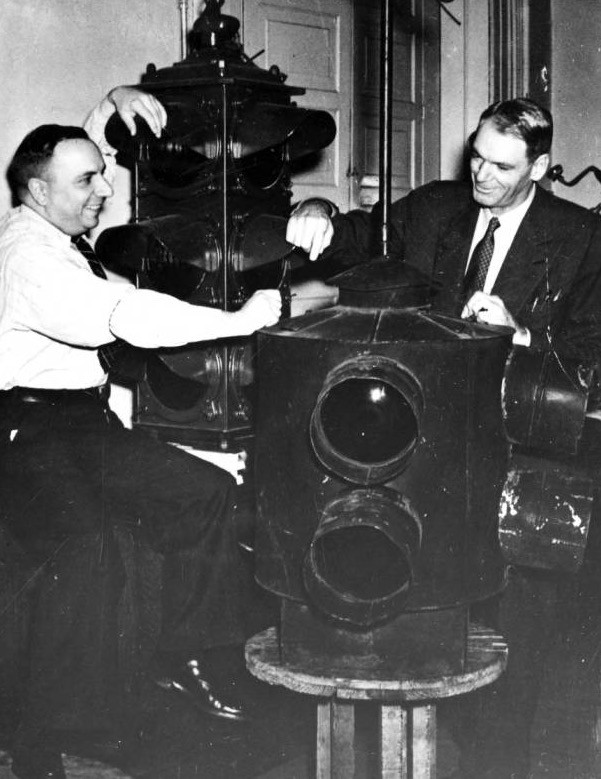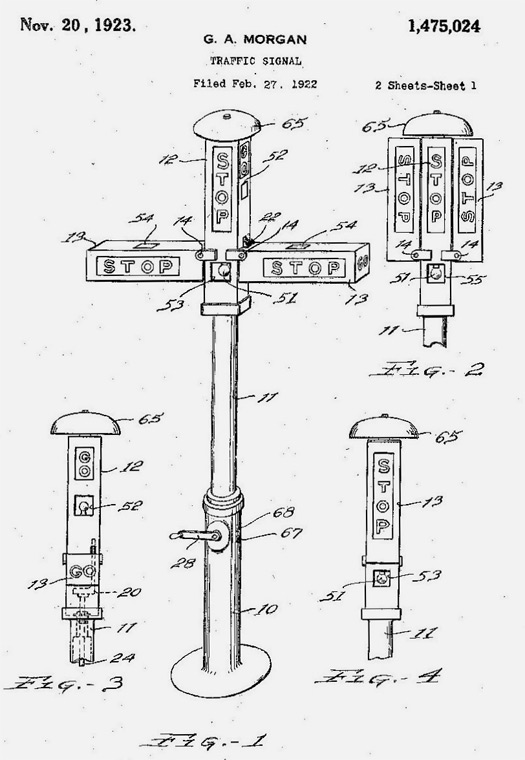
Lester Wire, with his two color traffic signal
The traffic signal was first invented in 1912 — by a Detroit policeman named Lester Wire — as a two-color, red-and-green light with a buzzer to warn pedestrians ahead of the impending transition. In 1920, this basic design was modified (by another policeman named William Potts) to include the tri-colored red, amber, and green lights widely used today. This simple, three-color icon has endured for nearly a century with relatively little change, save for the incorporation of modern technologies such as automatic timers, diode lights and motion sensors. The core of the three-color traffic remains true to the initial vision of two smart American policemen.
At the beginning of the 20th century, automobiles were just beginning to gain popularity in the streets of Detroit (where Potts worked) and traffic was becoming much busier as a result. Cars were relatively new and there were few rules at that time governing their use in the streets. The initial idea for the traffic light came from Potts’ experience working as a police officer directing traffic, and several elements contribute to the success of his design.
The traffic signal was first invented in 1912 — by a Detroit policeman named Lester Wire — as a two-color, red-and-green light with a buzzer to warn pedestrians ahead of the impending transition. In 1920, this basic design was modified (by another policeman named William Potts) to include the tri-colored red, amber, and green lights widely used today. This simple, three-color icon has endured for nearly a century with relatively little change, save for the incorporation of modern technologies such as automatic timers, diode lights and motion sensors. The core of the three-color traffic remains true to the initial vision of two smart American policemen.
At the beginning of the 20th century, automobiles were just beginning to gain popularity in the streets of Detroit (where Potts worked) and traffic was becoming much busier as a result. Cars were relatively new and there were few rules at that time governing their use in the streets. The initial idea for the traffic light came from Potts’ experience working as a police officer directing traffic, and several elements contribute to the success of his design.
First, Potts design chose colors that are psychologically associated with the message they are meant to transmit. Red is classically seen as a color representing danger or caution. (There are countless phrases and idioms that use “red” as a message of the bad or unknown — “in the red,” “seeing red,” and “red herring,” among others.) Green, on the other hand, is a reassuring color in most cultures — the color of nature and growth; of harmony, freshness, and fertility. Green has a strong emotional correspondence with the idea of safety, and was intuitively chosen to guide pedestrians responsibly through an intersection. Second, the traffic light could be counted on to communicate with multiple cars headed in multiple directions simultaneously. Potts’ design did not require any audio signals, so that wind, horns or other city noises would not interfere with the message being conveyed by the traffic control device. The four-direction design could transmit four simultaneous messages to the oncoming traffic, which was a noted improvement over the two-message maximum that a well-coordinated policeman could manage.
Finally, the traffic light reduced the workload of policemen by eliminating the dangerous job of controlling busy intersections. This allowed policemen to concentrate on other tasks like dispensing traffic violation tickets for impatient motorists who ran red lights. Following the success of the traffic light in Detroit, Garrett Morgan patented the design in 1923. It was later purchased by General Electric. GE then began building and marketing traffic lights for a national market. Nearly a century later, the traffic light remains as central to the life and safety of modern drivers and pedestrians as it ever was.

A patent drawing of Garrett Morgan's traffic signal
This post was originally published in June, 2010.


Comments [13]
06.14.10
12:12
06.14.10
01:44
When a light is about to turn yellow, the yellow AND green both come on. This gives you a heads up to hit the gas or get ready to stop. Then, when it does turn yellow, you are supposed to slow to stop. (I think the yellow only is shorter as a consequence which makes it easier to know, you ain’t gonna make it!)
They also have a yellow come on during red to alert you the light is about to turn green. I don't like this as it simply encourages green only jumpers and potential collisions. (At least it would in the U.S.)
People of Earth, any other variations that work better than just 3 colors?
06.14.10
11:00
06.15.10
03:55
Thanks for the reminder!
06.17.10
10:06
As a road safety person with two twitters @harveyhelmet and @s_i_n_s I appreciate a good understanding that doing it wrong is not driving. Having said that, the design itself, after modest modifications has become almost more dangerous that a stop sign. The concept of the countdown timer for pedestrian signals in combination has created a "beat the timer" attitude, by both pedestrians and cars. Most do not know, the push button actually lengthens crossing time by telling the intersection people are present. You can find busy streets of 8 lanes across and only 30s to get across, which is nearly impossible unless you won the 100m at a track & field event. Please visit my website www.johnrossharvey.com where I talk about the events causing traffic fatalities in my locality.
Signals are good, if they are observed, & obeyed. Sadly they are often not.
06.17.10
11:42
http://www.sheilaklein.com/pages/urband.htm
http://www.sheilaklein.com/pages/traffic.htm
06.17.10
03:08
06.17.10
05:14
06.22.10
08:06
11.07.10
07:13
01.20.11
01:49
Over 220,000 miles of railroad track covered the continental U.S. at the time and one aspect (pun intended) of this was the maddening pace for the installation of "block"signals to prevent trains from colliding. The "red" aspect was adopted in England in 1841 as the standard for "stop" which was immediately used worldwide.
A "Green" light was caution with "White" for a clear track. As any broken glass gave the "clear" indication, green was wholly substituted in the U.K. by the late 1890's as the least restrictive indication.
The New Haven railroad pioneered the use of red for stop, yellow for approach and green for clear in 1898 at Boston's South Station. By 1920, these three colors were universally adopted for railroad signals in the U.S. with three other colors for special purposes.
By 1911, "Medium-range (under 3,000 foot daylight visibility) electric colorlight signals" were widely used by the railroads, especially the street or trolley systems, which employed these electric lamp illuminated glass colors in cast iron housings surprisingly similar to those "invented" by Officer Potts.
Manufacturers were: Union Switch and Signal (Swissvale, Pennsylvania), General Railway Signal (Rochester, N.Y.) The Hall Signal Company (Garwood, New Jersey), the Nachod Signal Company and others.
Ref: The Railway Signal Dictionary, 1911 edition, Simmons-Boardman Publishing Co., New York
01.27.11
09:29
06.06.14
07:36